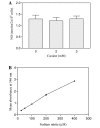Effects of chronic cocaine in rat C6 astroglial cells
- PMID: 22735768
- PMCID: PMC3391353
- DOI: 10.3892/ijmm.2012.1038
Effects of chronic cocaine in rat C6 astroglial cells
Abstract
Investigations with astroglial cells carry equal importance as those with neurons in drug abuse studies. The present study was aimed to investigate the effect of chronic cocaine administration on cell viability, nitric oxide (NO) production, general respiratory status of mitochondria and total protein levels in rat astroglioma cells after 24 h of treatment. In addition, the effect of cocaine was assessed for 24 h on brine shrimp larvae in order to study their sensitivity to the drug. It was observed that cocaine caused a significant dose-dependent decrease in astroglial cell viability with an LC(50) of 4.717 mM. It was found that cocaine did not induce or inhibit NO production in the cells. Evaluation of mitochondrial dehydrogenase activity in terms of formazan production in astroglial cells indicated that cocaine significantly interfered with the general respiratory status of mitochondria with an ED(50) of 6.153 mM. Furthermore, cocaine was shown to deplete the total protein levels in the cells with an ED(50) of 5.435 mM. In vivo study with brine shrimp larvae showed that these larvae were highly sensitive to cocaine with an ED(50) of 2.41 mM. In summary, our findings suggest that cocaine-induced cytotoxicity in the cells was non-specific. The cumulative effect arising from the significant loss of respiration and total cellular proteins is the cause of astroglial cell death.
Figures





Similar articles
-
Attenuating effect of N-acetyl-L-cysteine against acute cocaine toxicity in rat C6 astroglial cells.Int J Mol Med. 2013 Aug;32(2):497-502. doi: 10.3892/ijmm.2013.1391. Epub 2013 May 24. Int J Mol Med. 2013. PMID: 23708443 Free PMC article.
-
Cocaine induces alterations in mitochondrial membrane potential and dual cell cycle arrest in rat c6 astroglioma cells.Neurochem Res. 2010 Feb;35(2):288-97. doi: 10.1007/s11064-009-0053-2. Epub 2009 Sep 16. Neurochem Res. 2010. PMID: 19757036 Free PMC article.
-
Milk thistle seed extract protects rat C6 astroglial cells from acute cocaine toxicity.Mol Med Rep. 2014 Nov;10(5):2287-92. doi: 10.3892/mmr.2014.2524. Epub 2014 Aug 28. Mol Med Rep. 2014. PMID: 25174449 Free PMC article.
-
The protective role of D-glucose against 1-methyl-4-phenylpyridinium ion (MPP+): induced mitochondrial dysfunction in C6 astroglial cells.Neurochem Res. 2010 Sep;35(9):1413-21. doi: 10.1007/s11064-010-0200-9. Epub 2010 May 28. Neurochem Res. 2010. PMID: 20508987 Free PMC article.
-
Inhibition of mitochondrial respiration by nitric oxide: its role in glucose metabolism and neuroprotection.J Neurosci Res. 2005 Jan 1-15;79(1-2):166-71. doi: 10.1002/jnr.20281. J Neurosci Res. 2005. PMID: 15573411 Review.
Cited by
-
Cocaine potentiates an inflammatory response in C6 astroglia-like cells.Biomed Rep. 2021 May;14(5):45. doi: 10.3892/br.2021.1421. Epub 2021 Mar 16. Biomed Rep. 2021. PMID: 33786174 Free PMC article.
-
Attenuating effect of N-acetyl-L-cysteine against acute cocaine toxicity in rat C6 astroglial cells.Int J Mol Med. 2013 Aug;32(2):497-502. doi: 10.3892/ijmm.2013.1391. Epub 2013 May 24. Int J Mol Med. 2013. PMID: 23708443 Free PMC article.
-
Identification of biochemical and cytotoxic markers in cocaine treated PC12 cells.Sci Rep. 2018 Feb 9;8(1):2710. doi: 10.1038/s41598-018-21182-7. Sci Rep. 2018. PMID: 29426863 Free PMC article.
-
Hexachloronaphthalene Induces Mitochondrial-Dependent Neurotoxicity via a Mechanism of Enhanced Production of Reactive Oxygen Species.Oxid Med Cell Longev. 2020 Jun 26;2020:2479234. doi: 10.1155/2020/2479234. eCollection 2020. Oxid Med Cell Longev. 2020. PMID: 32685088 Free PMC article.
-
Cocaine Differentially Affects Mitochondrial Function Depending on Exposure Time.Int J Mol Sci. 2025 Feb 27;26(5):2131. doi: 10.3390/ijms26052131. Int J Mol Sci. 2025. PMID: 40076756 Free PMC article.
References
-
- National Institute on Drug Abuse: Cocaine: Abuse and Addiction. NIDA Research Report Series, Bethesda, MD, Revised September 2010.
-
- Li G, Xiao Y, Zhang L. Cocaine induces apoptosis in fetal rat myocardial cells through the p38 mitogen-activated protein kinase and mitochondrial/cytochrome c pathways. J Pharmacol Exp Ther. 2005;312:112–119. - PubMed
Publication types
MeSH terms
Substances
Grants and funding
LinkOut - more resources
Full Text Sources

